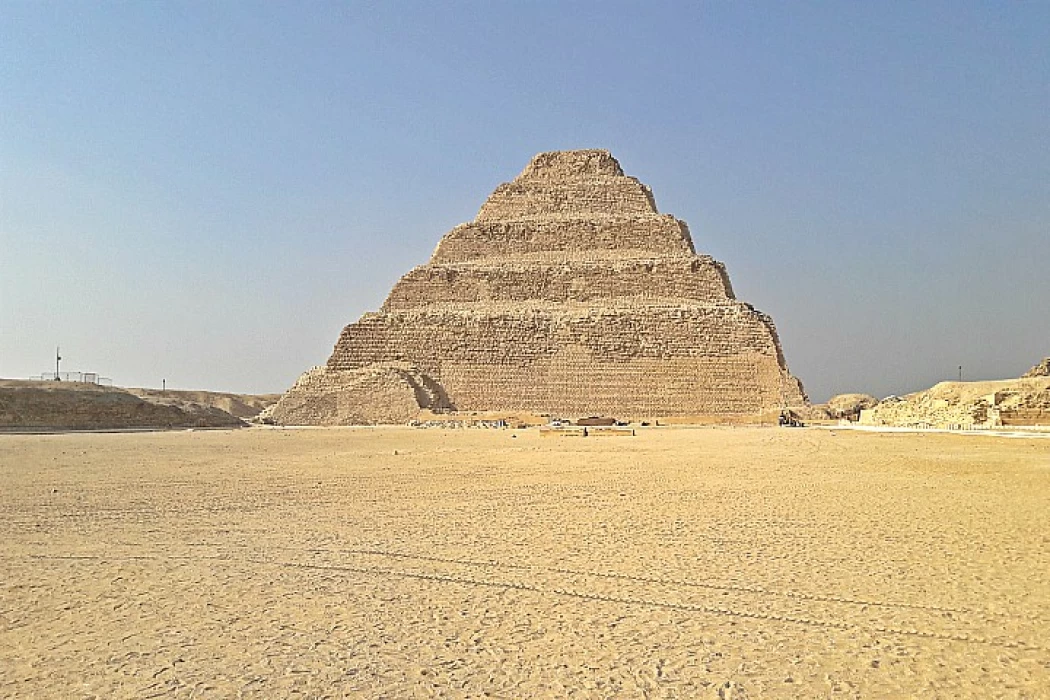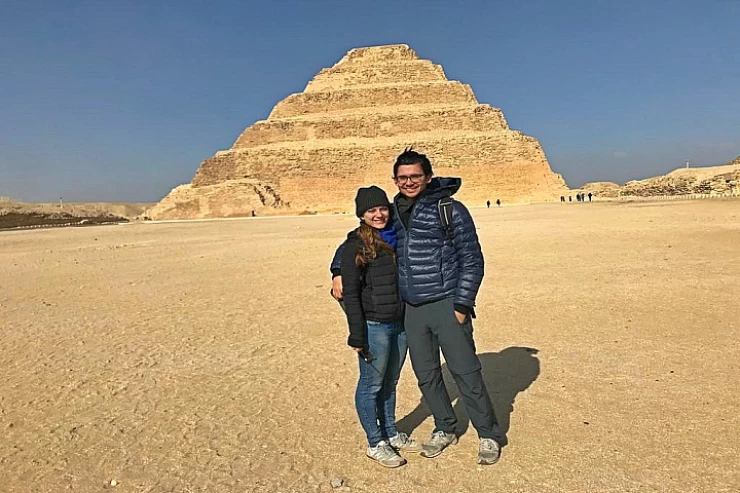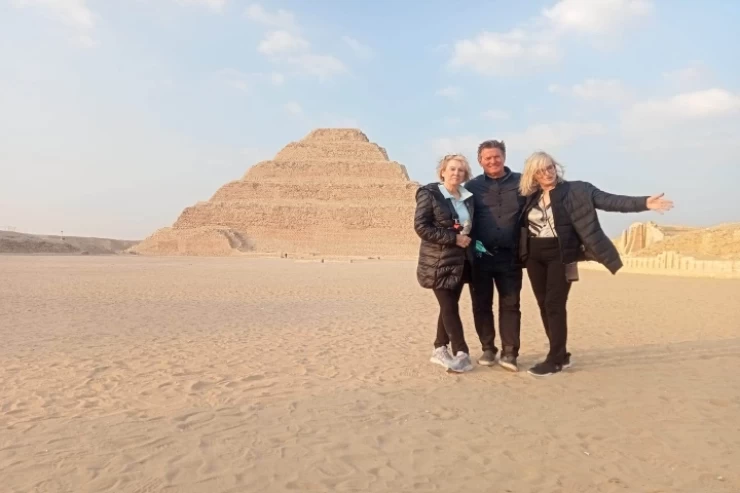A Pirâmide da Etapa
O terramoto de 1992 danificou seriamente a estrutura interna da pirâmide. Por este motivo, os trabalhos de restauro começaram em 2006 e duraram 14 anos através de muitas dificuldades. Em 2011, as obras sofreram uma interrupção devido à revolução, estando agora abertas a visitantes e turistas de todo o mundo.
Dentro da Pirâmide da Etapa
A Pirâmide de Passos do Rei Djoser em Saqqara é uma das coisas mais importantes a fazer no Cairo ou talvez em todo o Egipto.
Pirâmide de Djoser
Esta estrutura mostra-nos o desenvolvimento da construção da pirâmide. É a pirâmide inicial construída no Egipto e embora não seja uma "verdadeira pirâmide" com lados lisos, como as Pirâmides de Gizé e a Pirâmide de Bent, e a Pirâmide Vermelha de Dahshur.
A primeira estrutura de pedra cortada em grande escala no mundo consiste em seis degraus, sobrepostos uns sobre os outros. O arquitecto de Djoser decidiu empilhar várias destas estruturas para criar um monumento mais imponente ao faraó, que tem 203 pés de altura.
O cientista mais famoso que tem de ser mencionado sempre que falamos de Sakkara é Jean-Philippe Lauer, que é um arqueólogo francês que restaurou e reconstruiu as partes danificadas do complexo.
No lado norte da pirâmide, o templo da pirâmide distingue-se, enquanto nos complexos de pirâmide seguintes é sempre visto no lado leste. O complexo de Step Pyramid é rodeado por uma parede de pedra calcária com 10,5 m de altura, conhecida como fachada do palácio, que imita feixes de canas encadernadas. A estrutura geral imita o tijolo de lama. A muralha tem 14 portas de palha, mas apenas uma entrada real, no canto sul da fachada leste, é para os vivos. As restantes portas são conhecidas como portas falsas, para uso do rei na vida após a morte.
Depois entramos na passagem da colunata coberta com um tecto de calcário feito de troncos de árvores inteiros, o que levou a uma imitação maciça de pedra de duas portas abertas foi um salão com vinte pares de colunas de calcário construídas para parecerem feixes de caules de plantas e atingindo uma altura de 6,6 m. As colunas não estavam de pé livre, mas estavam presas às projecções das paredes. Entre as colunas de ambos os lados do salão havia pequenas câmaras, que foram sugeridas para cada uma das províncias do Alto e Baixo Egipto. No final da colunata estava o salão transversal hipoestilo com oito colunas ligadas em pares por blocos de calcário. Há pedras curvas no interior do judiciário que se pensa serem marcadores associados ao festival de Heb-sed, um importante ritual completado por reis egípcios quando completaram 30 anos para renovar os seus poderes.
No extremo sul do tribunal havia uma plataforma aproximada por degraus. Foi recomendado que este fosse um princípio para o trono duplo. Todo o complexo da Pirâmide da Etapa simboliza o recinto do palácio real e permite ao rei realizar os rituais associados à realeza. A Tumba do Sul muito a sul da Corte Sul estava
A câmara funerária que não pode ser visitada no momento durante o Cairo Day Tours é feita abaixo de um poço profundo de 28 metros de profundidade, bem como um túnel de câmaras e galerias ligadas a um poço central e depois à sala funerária do rei, o enterro de membros da família, e o armazenamento de bens e ofertas.
Nossos passeios pelo Egito geralmente visitam a pirâmide de degraus e cobrem a maioria dos sítios arqueológicos durante uma série de passeios pelo Egito, passeios de um dia no Cairo saindo do aeroporto, pacotes de viagem para o Egito, passeios de um dia no Egito, etc: Nós lhe daremos as boas-vindas indescritíveis a essa terra abençoada do Egito com a ajuda de nossos guias qualificados e preparados.
Se você quiser saber mais sobre Gizé e ver como ela é, poderá encontrar muitas informações e fotos de um edifício especial chamado Mesquita de Taghri Bardi, no Cairo. Ela lhe ensinará mais sobre como Gizé foi construída há muito tempo.
Located in the vast expanses of Saqqara in the outer suburb of Cairo, the Step Pyramid of Djoser is indeed one of the strongest, yet most ancient, structures that Egypt boasts about. Often regarded as the first structure to implement large-scale stone construction techniques, this monumental building can be said to have spearheaded the era of pyramid construction in ancient Egypt. Built over 4600 years ago, the mysterious construction with a wide array of shapes, stories, and usages still exists and inspires archeologists, historians, and tourists to this day.
Historical background and significance
The Step Pyramid, otherwise referred to as the Pyramid of Djoser, was constructed in the 27th century BCE under the reign of the Pharaoh Djoser, who was the second monarch of Egypt's Third Dynasty. Djoser was a progressive king who wanted something more than apostolic vertical graves—mastabas—that man who is into a flat-topped tomb design created for a range of other pharaohs, including his steps. He commissioned the project to his most trusted architect, Imhotep, whom history would remember for far greater things than mere architecture.
Imhotep, who was an architect ahead of his time and the high priest, aspired to build a monument that was not only grand in the eyes of the Pharaoh but would also see a safe flight to Osiris. To achieve this, he invented a new architectural design, which was known as a step pyramid, by vertically stacking six nesting mastabas of increasingly smaller size. This great edifice not only served to elevate the status of Djoser in death but also transformed the architectural landscape of ancient Egypt forever.
The Step Pyramid measures around 62 meters (203 feet) in height, and it was the highest structure back then. Imhotep set a new trend in construction by building the pyramid with stone instead of mudbrick, which was used before. The pyramid is made up of six levels, or steps, each of which rises toward the peak of the structure, forming a staircase that is believed to help the king’s spirit ascend to heaven.
The pyramid complex is quite spacious, covering about 15 hectares (37 acres) and surrounded by a limestone wall with 14 false doors and one real door. This ingenious design had both symbolic and functional value, as it shrouded the pharaoh’s burial place in an aura of mystery and secured him from any invaders. Once inside the enclosure, one can find dozens of different buildings, such as temples and courtyards as well as the South Tomb, all of which are meant to help the deceased king reach the other world as well as serve religious practices.
Impressive underground tunnels form one of the exceptional aspects of the Step Pyramid complex. The vast stretch of 5.7 km (3.5 miles) of these vaults has more than 40, 000 stone jars engraved with the names of other kings before Djoser. The painstaking detail in the arrangement of these tunnels speaks volumes about the ideas of the ancient Egyptians concerning the protection of the treasures of the king for all time.
Imhotep, who came up with the concept of the Step Pyramid, was a Renaissance man qualified in several fields, including architecture, medicine, and religion. Because of his involvement in building the Step Pyramid, he received a lot of fame and respect. He was so influential that he was treated like a god of medical and healing arts more than a century after his death. His innovative way of using stones for construction made way for the enormous pyramids that would come after, such as the Great Pyramid of Giza.
Imhotep's design for the Step Pyramid complex also shows how much he grasps engineering with religion. The superficial step structure of pyramids represents a symbol of ascending toward the gods for the pharaohs, while the inner courtyards and temples are a representation of the cultural aspects of ancient Egyptian society rituals. This ability to balance the need for functional design and altar design envisioning the mass-transforming power of spirits reaffirms his place as one of the best architects in history.
Religious and cultural importance
Step Pyramid is a representation of sacredness in the sense that it is both a tomb and, in this case, a door to another dimension of life. The pharaohs were believed to be the people who could mingle with the gods and, thus, were considered divine. In connection with this, Djoser built the Step Pyramid to protect his divine status as well as ensure that his spirit would traverse safely into other planes of existence.
The course of the pyramid complex construction is accurate in that it shows cardinal directions and contains elements associated with the transport of the great pharaohs. The South Court, which is a large region devoid of any enclosing interior wall, was most likely enlarged in anticipation of the Heb-Sed celebration, which was a ritual that granted legitimacy to the king and spelled his right to rule. This was an opportunity for Djoser to ascertain himself as still living and well, even after he had been buried.
Furthermore, the other enclosing chapels and temples were also built for the priests, who were responsible for conducting the daily ceremonies to the spirit of Djoser, the king, and feeding him for his eternal journey. Such a practice of worshipping the dead in this manner emphasized the unending cycle of life, death, and rebirth, as was the case with the ancient Egyptians, which characterized their way of life.
The Djoser's Step Pyramid laid the foundations for a new generation of pyramids with smooth surfaces that dominated ancient Egyptian architecture. The success of Djoser’s monument brought on the following pharaohs, who commissioned larger and larger pyramids, which resulted in the Giza pyramids.
The Step Pyramid made a few improvements that would later be typical in the design of pyramid complexes. Many of these construction elements—stone quarrying, basement burial chambers, and the giant scale of the structure—were factors that pioneered the development of building pyramids. Djoser’s Step Pyramid is probably the main reason why such enormous pyramids as those of Sneferu, Khufu et al. were constructed.
For many generations, the Step Pyramid remained the symbol of the architectural accomplishment of the ancient Egyptians, but with time, it underwent much erosion. Starting from the year 1900, one British archeologist by the name of Cecil Firth made his way to Saqqara and commenced excavation works, which led to the discovery of most of the structures in the pyramid complex. Over the years, some other excavators have also managed to do a little more work at this remarkable structure.
Recently, however, restoration work has been carried out to restore the Step Pyramid for posterity. The extensive work involves, among other things, the stabilization of the internal chambers and the reconstruction of the outer walls. Such projects thankfully aim to compromise as little as possible on the original purpose of the building and allow this landmark building to testify for even more years about the culture and history of the country.
Visiting the Step Pyramid Today
Currently, tourists visiting Djoser’s Step Pyramid can enjoy not just the structure itself but the entire complex, which also reveals the elements of ancient Egyptian art and religion. Entering through the stone doors and strolling around the open sections, one can almost feel the presence of a bygone era dominated by Kings and the making of everlasting structures.
Nevertheless, Saqqara’s Step Pyramid is also one of the top places to see for every traveler, every historian, and every admirer of the undying civilization of Ancient Egypt. It is a monument of Pharaoh Djoser’s dreams as well as of the genius called Imhotep, the wonder that mankind still looks up to even after 4600 years of its existence.



















